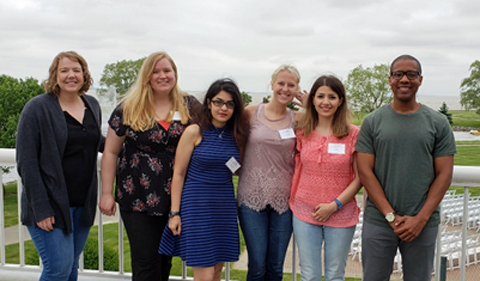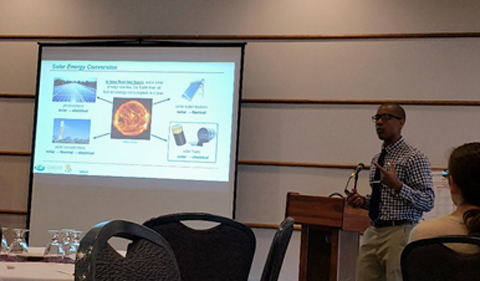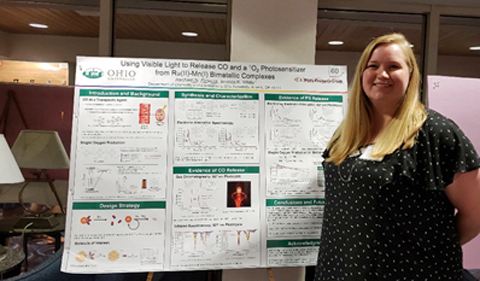
From left: Dr. Jessica K. White, Rachael Pickens (J. K. White group), Shabnam Pordel (J. K. White group), Samantha Roe (T. A. White group), Sima Saeedi (T. A. White group), Dr. Travis A. White.
Two research groups from the Chemistry & Biochemistry Department at Ohio University recently gave an invited talk and a poster presentation at the Maumee Bay State Park in Oregon, OH, to attend the Group (OoPS) meeting.
Dr. Travis A. White, Assistant Professor of Chemistry & Biochemistry, presented an invited talk titled “Driving solar hydrogen production with heteroleptic Cu(I) photosensitizers.” For more information regarding photocatalytic water reduction to hydrogen fuel, contact Travis White at whitet2@ohio.edu.
Rachael Pickens, a graduate student in Dr. Jessica K. White’s group, presented a poster titled “Red light-activated release of CO cargo from Ru(II)-diimine photosensitizers. For more information regarding light-activated release of small molecules with potential therapeutic applications, contact Jessica White at whitej7@ohio.edu.
The conference focused on fundamental and application-based photophysics and photochemistry research conducted in Ohio and surrounding states. The three-day conference, May 31 through June 2, featured oral presentations and posters delivered by faculty, post-doctoral researchers, graduate students, and undergraduate students, which served to foster fruitful discussions and establish potential collaborative research.
Abstract for “Driving solar hydrogen production with heteroleptic Cu(I) photosensitizers”
Prof. Travis A. White (whitet2@ohio.edu)
Storing solar energy in the form of chemical bonds (i.e. solar fuels) is an attractive approach to generate renewable and storable energy sources. At the molecular level, understanding the factors that dictate light absorption, charge separation, catalyst-substrate interaction, and system regeneration provides valuable insight towards the design of more efficient photocatalytic systems. Our current research investigates the use of heteroleptic, visible light-absorbing Cu(I) photosensitizers (PS) in combination with bis-polypyridyl Rh(III) water reduction catalysts (WRC) for applications in solar hydrogen production. Cu(I) PS of the design [(PP)Cu(R2-biq)]PF6 (PP = bidentate diphosphine ligand; R2-biq = substituted 2,2′-biquinoline ligand) are capable of visible light absorption beyond 500 nm to populate emissive charge transfer excited states with lifetimes up to 400 ns at room temperature. Photoexcitation in the presence of an electron donor reductively quenches the Cu(I) PS excited state, affording a one-electron reduced PS capable of electron transfer to a Rh(III) WRC and subsequent hydrogen evolution. The identity of the ligands on the Cu(I) PS and Rh(III) WRC strongly impacts the photocatalytic activity by varying the structural, redox, and photophysical properties, the results of which will be presented.
Abstract for “Red light-activated release of CO cargo from Ru(II)-diimine photosensitizers”
Rachael N. Pickens (rp717713@ohio.edu)
The exploration of new frameworks to deliver therapeutic molecules for the treatment of diseases such as cancer is an important application of photoactivatable metal complexes. A variety of complexes given the term photoCORMs (photoactivated CO-releasing molecules) provides a route to spatiotemporally activate the delivery of CO to a desired target. CO as a cancer therapy is under investigation and may provide a way to avoid drug resistance commonly experienced by conventional chemotherapy. The photosensitization of cytotoxic singlet oxygen using Ru(II) polypyridyl complexes is also an area of interest as a phototherapeutic tool. Two Ru(II)-Mn(I) bimetallic complexes, [(bpy)2Ru(BL)Mn(CO)3Br](PF6)2 (where BL= 2,2ʹ-bipyrimidine or 2,3-bis(2-pyridyl)pyrazine) were designed to combine these two therapeutic agents by providing both a [(bpy)2Ru(BL)]2+ singlet oxygen photosensitizer and multiple equivalents of CO under irradiation. When irradiated with red light, the complexes release three equivalents of CO as determined by gas chromatography and infrared spectroscopy, while the light-induced generation of the photosensitizer was monitored using electronic absorption spectroscopy. The synthesis, characterization, and photoinduced ligand dissociation of the Ru(II)-Mn(I) complexes will be presented.





















Comments